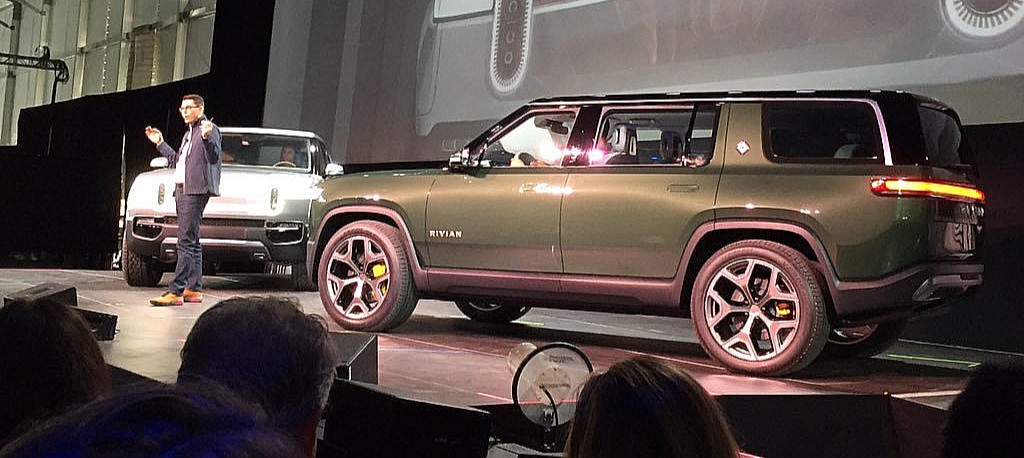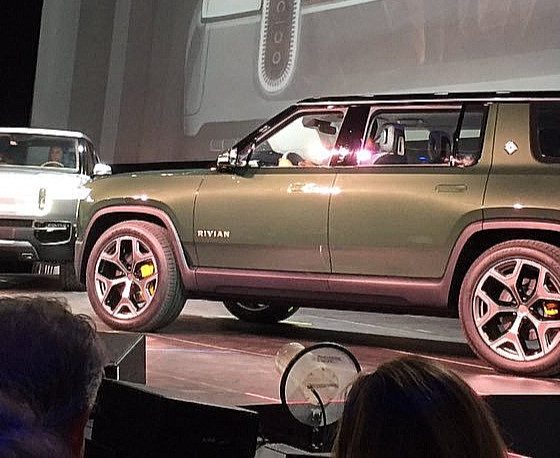

News
Rivian CEO talks auxiliary batteries and ‘Jurassic Park’ style self-driving tours
As Rivian continues to set the stage for the production of its first two vehicles — the R1T pickup truck and the R1S SUV — CEO RJ Scaringe has started dropping some compelling new details about the two upcoming all-electric outdoor adventure vehicles. In a recent interview, the 35-year-old CEO mentioned a couple of upcoming features for the R1S and the R1T, such as an auxiliary battery that acts like a “digital jerry can” and autonomous capabilities that echo some iconic scenes from Hollywood.
Scaringe’s recent statements were related in an interview with Tesla owner-enthusiast Sean Mitchell of All Things EV. During the interview, the Rivian CEO and the longtime electric car owner talked about the R1T and the R1S’ batteries, their autonomous features, and even their charging infrastructure. Needless to say, it appears that the startup electric car maker has a number of compelling announcements in the pipeline.
A particularly compelling detail related by Scaringe involved the R1T and the R1S’s batteries. Being luxury adventure vehicles, the pickup truck and SUV are designed to go on long trips and travel off the beaten path without running out of range. As noted by the Rivian CEO, range is the primary reason behind the company’s extra large battery packs, which are offered at 105 kWh, 135 kWh, and 180 kWh configurations. With its largest battery pack, the Rivian R1T and R1S are expected to be capable of traveling more than 400 miles per charge.
To further avoid any range anxiety, Scaringe added that Rivian is currently working to install chargers at notable outdoor adventure locations, such as national parks and ski resorts. In the event that extra range is needed on the go, the CEO revealed that Rivian is also working on creating auxiliary batteries that work like a portable, extra tank of fuel which could provide the R1S and the R1T with extra range to make it to a charging station.
During the vehicle’s unveiling, Rivian noted that its vehicles would feature autonomous capabilities. To enable this, both the R1S and the R1T are equipped with a suite of cameras, radar, ultrasonic sensors, high-precision GPS technologies, and two, cleverly-placed LiDAR. Scaringe described some of Rivian’s upcoming autonomous features, including a self-driving tour function reminiscent of the iconic SUVs in the classic Steven Spielberg film Jurassic Park.
“Let’s say you are in a national park. We can give you a guided tour of that park, you know, narrated and explaining what you’re seeing, but it’s like the vehicles are on “digital rails,” sort of Jurassic Park style, as it drives around the park. These are some of the features we’re gonna be showing over the course of next year,” Scaringe said.
Both the Rivian R1T and R1S are designed to be just as capable in rough terrain as they are on paved roads. Thanks to their heavy battery packs, Scaringe noted that both vehicles actually have a low center of gravity despite their high ground clearance. This also gives the pickup truck and SUV stability and impeccable handling. The four electric motors used in the R1T and R1S provide the cars with some impressive performance specs as well, such as a 0-60 mph time of 3.0 seconds for the 135 kWh variant. Rivian has opened its pickup truck and SUV for reservations, with production expected to start at 2020.
Watch Rivian CEO RJ Scaringe’s recent interview with Sean Mitchell in the video below.

News
Tesla FSD fleet is nearing 7 billion total miles, including 2.5 billion city miles
As can be seen on Tesla’s official FSD webpage, vehicles equipped with the system have now navigated over 6.99 billion miles.

Tesla’s Full Self-Driving (Supervised) fleet is closing in on almost 7 billion total miles driven, as per data posted by the company on its official FSD webpage.
These figures hint at the massive scale of data fueling Tesla’s rapid FSD improvements, which have been quite notable as of late.
FSD mileage milestones
As can be seen on Tesla’s official FSD webpage, vehicles equipped with the system have now navigated over 6.99 billion miles. Tesla owner and avid FSD tester Whole Mars Catalog also shared a screenshot indicating that from the nearly 7 billion miles traveled by the FSD fleet, more than 2.5 billion miles were driven inside cities.
City miles are particularly valuable for complex urban scenarios like unprotected turns, pedestrian interactions, and traffic lights. This is also the difference-maker for FSD, as only complex solutions, such as Waymo’s self-driving taxis, operate similarly on inner-city streets. And even then, incidents such as the San Francisco blackouts have proven challenging for sensor-rich vehicles like Waymos.
Tesla’s data edge
Tesla has a number of advantages in the autonomous vehicle sector, one of which is the size of its fleet and the number of vehicles training FSD on real-world roads. Tesla’s nearly 7 billion FSD miles then allow the company to roll out updates that make its vehicles behave like they are being driven by experienced drivers, even if they are operating on their own.
So notable are Tesla’s improvements to FSD that NVIDIA Director of Robotics Jim Fan, after experiencing FSD v14, noted that the system is the first AI that passes what he described as a “Physical Turing Test.”
“Despite knowing exactly how robot learning works, I still find it magical watching the steering wheel turn by itself. First it feels surreal, next it becomes routine. Then, like the smartphone, taking it away actively hurts. This is how humanity gets rewired and glued to god-like technologies,” Fan wrote in a post on X.
News
Tesla starts showing how FSD will change lives in Europe
Local officials tested the system on narrow country roads and were impressed by FSD’s smooth, human-like driving, with some calling the service a game-changer for everyday life in areas that are far from urban centers.

Tesla has launched Europe’s first public shuttle service using Full Self-Driving (Supervised) in the rural Eifelkreis Bitburg-Prüm region of Germany, demonstrating how the technology can restore independence and mobility for people who struggle with limited transport options.
Local officials tested the system on narrow country roads and were impressed by FSD’s smooth, human-like driving, with some calling the service a game-changer for everyday life in areas that are far from urban centers.
Officials see real impact on rural residents
Arzfeld Mayor Johannes Kuhl and District Administrator Andreas Kruppert personally tested the Tesla shuttle service. This allowed them to see just how well FSD navigated winding lanes and rural roads confidently. Kruppert said, “Autonomous driving sounds like science fiction to many, but we simply see here that it works totally well in rural regions too.” Kuhl, for his part, also noted that FSD “feels like a very experienced driver.”
The pilot complements the area’s “Citizen Bus” program, which provides on-demand rides for elderly residents who can no longer drive themselves. Tesla Europe shared a video of a demonstration of the service, highlighting how FSD gives people their freedom back, even in places where public transport is not as prevalent.
What the Ministry for Economic Affairs and Transport says
Rhineland-Palatinate’s Minister Daniela Schmitt supported the project, praising the collaboration that made this “first of its kind in Europe” possible. As per the ministry, the rural rollout for the service shows FSD’s potential beyond major cities, and it delivers tangible benefits like grocery runs, doctor visits, and social connections for isolated residents.
“Reliable and flexible mobility is especially vital in rural areas. With the launch of a shuttle service using self-driving vehicles (FSD supervised) by Tesla in the Eifelkreis Bitburg-Prüm, an innovative pilot project is now getting underway that complements local community bus services. It is the first project of its kind in Europe.
“The result is a real gain for rural mobility: greater accessibility, more flexibility and tangible benefits for everyday life. A strong signal for innovation, cooperation and future-oriented mobility beyond urban centers,” the ministry wrote in a LinkedIn post.
News
Tesla China quietly posts Robotaxi-related job listing
Tesla China is currently seeking a Low Voltage Electrical Engineer to work on circuit board design for the company’s autonomous vehicles.

Tesla has posted a new job listing in Shanghai explicitly tied to its Robotaxi program, fueling speculation that the company is preparing to launch its dedicated autonomous ride-hailing service in China.
As noted in the listing, Tesla China is currently seeking a Low Voltage Electrical Engineer to work on circuit board design for the company’s autonomous vehicles.
Robotaxi-specific role
The listing, which was shared on social media platform X by industry watcher @tslaming, suggested that Tesla China is looking to fill the role urgently. The job listing itself specifically mentions that the person hired for the role will be working on the Low Voltage Hardware team, which would design the circuit boards that would serve as the nervous system of the Robotaxi.
Key tasks for the role, as indicated in the job listing, include collaboration with PCB layout, firmware, mechanical, program management, and validation teams, among other responsibilities. The role is based in Shanghai.
China Robotaxi launch
China represents a massive potential market for robotaxis, with its dense urban centers and supportive policies in select cities. Tesla has limited permission to roll out FSD in the country, though despite this, its vehicles have been hailed as among the best in the market when it comes to autonomous features. So far, at least, it appears that China supports Tesla’s FSD and Robotaxi rollout.
This was hinted at in November, when Tesla brought the Cybercab to the 8th China International Import Expo (CIIE) in Shanghai, marking the first time that the autonomous two-seater was brought to the Asia-Pacific region. The vehicle, despite not having a release date in China, received a significant amount of interest among the event’s attendees.








